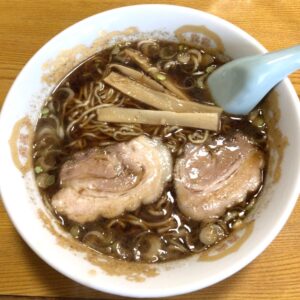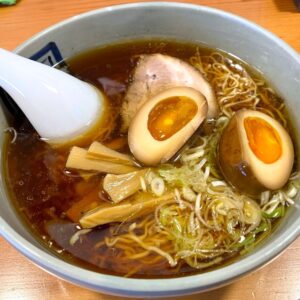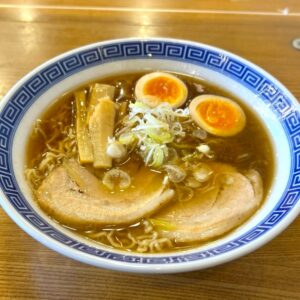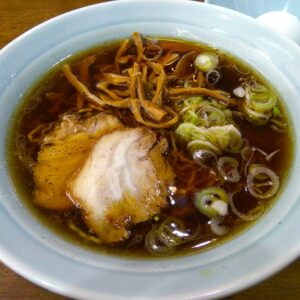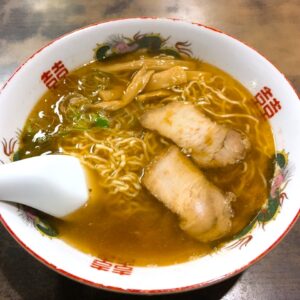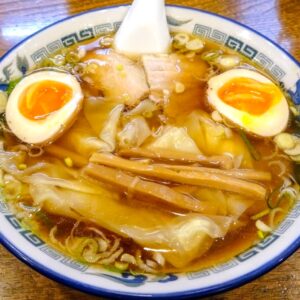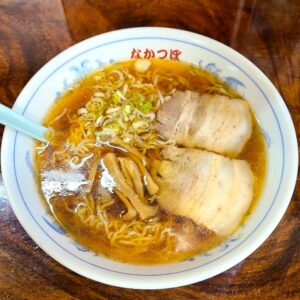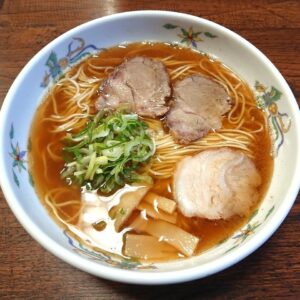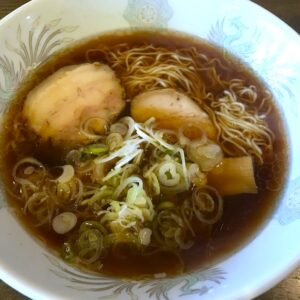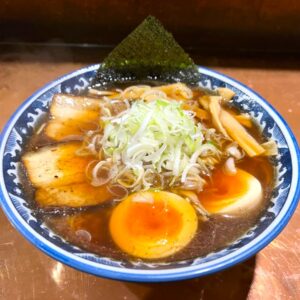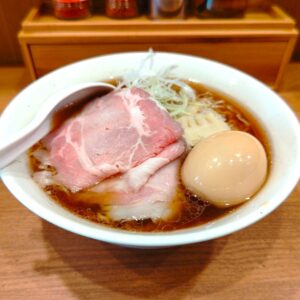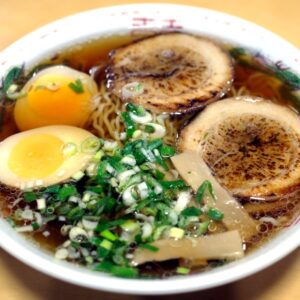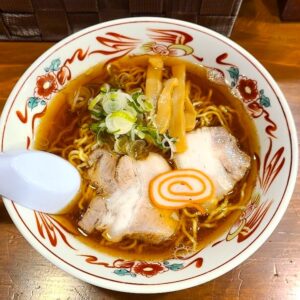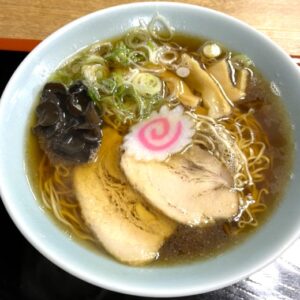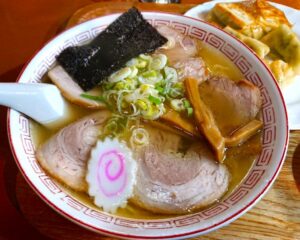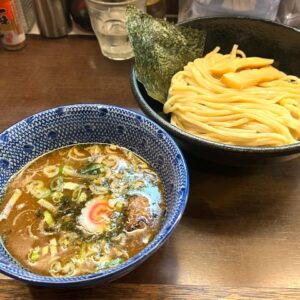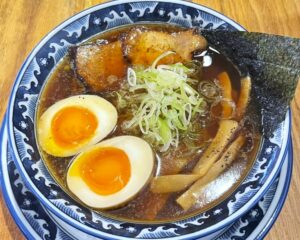Takayama Ramen (Gifu Pref.)
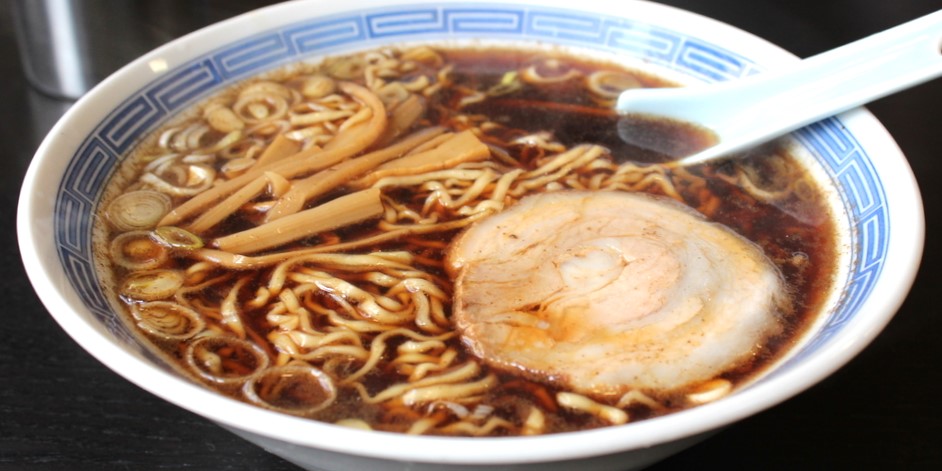
What is Takayama Ramen(高山ラーメン)?
Takayama Ramen(高山ラーメン) is a local delicacy mainly eaten in Takayama City, Gifu Prefecture(岐阜県), and is also called Hida Takayama Ramen(飛騨高山ラーメン) or Hida Ramen(飛騨ラーメン). Its main feature is that it has thin curly noodles in a Japanese-style soy sauce soup.
The soup is a clear soup mainly made with chicken bones, dried sardines, Japanese-style stock such as bonito flakes, and vegetables. Generally, sauce is poured into a bowl and mixed with soup, but in Hida Takayama, soy sauce and mirin are added directly to the soup to add flavor.
Locals don’t often refer to it as ramen, but instead write it as “Chūka Soba(Chinese Noodle;中華そば)” or “Soba(Noodle;そば).”
Light during the day, rich at night
Local ramen refers to ramen that has a similar style in a certain region, has a history, and is loved by locals for its taste. However, in a normal city, there should be ramen that doesn’t fall into that category. However, in Takayama, the ramen was so similar that it made me wonder, “Is there really a different type of ramen?” Maybe the store I chose happened to be like that. I ate at seven shops, and all seven were truly “Takayama ramen.” Of course, there are slight differences in taste, but the characteristics are almost the same.
Let’s explain it with the ramen from the original “Masago(まさご)” (founded in 1938). Flat, thin, curly noodles with a low water content, white and crisp. Kansui doesn’t seem to be used either. This noodle has its own characteristics, and those who don’t like it will probably not like Takayama ramen. The soup is clear and has a slightly strong flavor, with a base of chicken bones, dried sardines, Japanese-style stock such as bonito flakes, and vegetables.
And this soup has an even bigger feature that defies common sense. Normally, when making ramen noodles, the dashi stock is collected and mixed with the sauce to make the soup. However, here in Takayama, the soy sauce sauce is added to the soup stock. In other words, the only thing that goes into the bowl is the soup extracted from this Zundou(寸胴; cylindrical container, soupstock pot). Without the sense of “sauce(タレ tare or カエシ kaeshi),” salt ramen and miso ramen are impossible. It seems that some stores serve it, but most of the time it’s all about the soy sauce flavor. How did this happen? Apparently, the same tricks they used to lighten the workload when they were thriving are still being put to good use.
How does the soup taste when you add the sauce and simmer it? Naturally, the later it gets, the more it simmers and the flavor becomes stronger. Yes, that’s exactly right, and since everyone knows it, there’s no problem. This is a reversal of the idea. It’s light during the day and rich and rich at night. Locals know what time they like to eat, so you can go there at that time. It sounds like a joke, but it’s true.
The ingredients are simple: chashu pork belly, menma bamboo shoots, and negi green onions. The chashu pork belly is used to supplement the oil content of the light, Japanese-flavored soup. The green onions are local Nebuka green onions(根深ネギ Nebuka Negi) (also called Hida green onions 飛騨ネギ Hida Negi), which have a strong sweet taste.
Here in Takayama, it’s not even called RAMEN. It is “Chuka Soba(中華そば; Chinese noodle”. Moreover, most locals call it “Soba(そば;Noodle). This “Soba (Chinese noodle)” is also eaten on New Year’s Eve.
*Japanese people have the custom of eating Japanese soba (年越し蕎麦, Toshikoshi Soba) on New Year’s Eve.
Soba is called “Nihon Soba(日本そば;Japanese soba noodles)” or “Nama Soba(生そば; fresh soba noodles).” The exteriors and interiors of the stores seem to be in keeping with the cityscape, as many of them are typical of soba shops in Tokyo. It’s a nice townscape to eat while you’re sightseeing.
Other popular shops besides “Masago(まさご)” include “Yayoi Soba(やよいそば),” which has also opened at the Shin-Yokohama Ramen Museum, “Mametengu(豆天狗),” “Kadoya(角や),” “Jingoro(甚五郎),” “Kikyouya(桔梗屋),” and “Ebisaka(えび坂).” Please note that the ”Hida Takayama Ramen” from chain stores in Tokyo and elsewhere is very different from the actual “Takayama Ramen”, so please avoid any misunderstandings.

